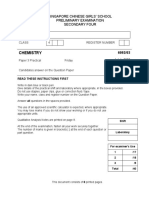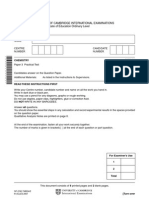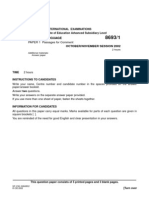Chemistry: University of Cambridge International Examinations General Certificate of Education Ordinary Level
Chemistry: University of Cambridge International Examinations General Certificate of Education Ordinary Level
Uploaded by
mstudy123456Copyright:
Available Formats
Chemistry: University of Cambridge International Examinations General Certificate of Education Ordinary Level
Chemistry: University of Cambridge International Examinations General Certificate of Education Ordinary Level
Uploaded by
mstudy123456Original Title
Copyright
Available Formats
Share this document
Did you find this document useful?
Is this content inappropriate?
Copyright:
Available Formats
Chemistry: University of Cambridge International Examinations General Certificate of Education Ordinary Level
Chemistry: University of Cambridge International Examinations General Certificate of Education Ordinary Level
Uploaded by
mstudy123456Copyright:
Available Formats
This document consists of 5 printed pages and 3 blank pages.
SP (SJF3292) S77886/4
UCLES 2005 [Turn over
UNIVERSITY OF CAMBRIDGE INTERNATIONAL EXAMINATIONS
General Certificate of Education Ordinary Level
CHEMISTRY 5070/03
Paper 3 Practical Test
May/June 2005
1 hour 30 minutes
Candidates answer on the Question Paper.
Additional Materials: As listed in the Instructions to Supervisors.
READ THESE INSTRUCTIONS FIRST
Write your Centre number, candidate number and name in the spaces at the top of this page.
Write in dark blue or black pen in the spaces provided on the Question Paper.
You may use a pencil for any diagrams, graphs or rough work.
Do not use staples, paper clips, highlighters, glue or correction fluid.
You may use a calculator.
Answer all questions.
The number of marks is given in brackets [ ] at the end of each question or part question.
Qualitative analysis notes are printed on page 8.
You should show the essential steps in any calculation and record experimental results in the spaces
provided on the question paper.
Centre Number Candidate Number Name
For Examiners Use
1
2
TOTAL
If you have been given a label, look at the
details. If any details are incorrect or
missing, please fill in your correct details
in the space given at the top of this page.
Stick your personal label here, if
provided.
2
5070/03/M/J/05
BLANK PAGE
3
5070/03/M/J/05 [Turn over
For
Examiners
Use
UCLES 2005
1 P is a solution of hydrochloric acid (HCl) of unknown concentration. You are to determine its
concentration by titrating it against solution Q, which is 0.100 mol/dm
3
sodium hydroxide.
(a) Determination of the concentration of the acid in P
Put P into the burette.
Pipette a 25.0 cm
3
(or 20.0 cm
3
) portion of Q into a flask and titrate with P, using the
indicator provided.
Record your results in the table, repeating the titration as many times as you consider
necessary to achieve consistent results.
Results
Burette readings
Summary
Tick () the best titration results.
Using these results, the average volume of P required was cm
3
.
Volume of solution Q used cm
3
. [12]
(b) Q is 0.100 mol/dm
3
sodium hydroxide.
Using your results from (a), calculate the concentration, in mol/dm
3
, of the hydrochloric
acid in P.
Concentration of hydrochloric acid in P......................... mol/dm
3
. [2]
Titration number 1 2
Final reading / cm
3
Initial reading / cm
3
Volume of P used / cm
3
Best titration results ()
4
5070/03/M/J/05
For
Examiners
Use
UCLES 2005 5070/03/M/J/05
2 You are provided with solutions of two sodium salts, R and S. Carry out the following tests
and record your observations in the table. You should test and name any gas evolved.
Tests on Solution R
[15]
Test
no.
1
2
Test
(a) To a portion of solution R, add an
equal volume of dilute
hydrochloric acid and allow the
mixture to stand for a few
minutes.
To a portion of acidified potassium
manganate(VII), add an equal volume
of solution R and allow the mixture to
stand for a few minutes.
3
4
To a portion of aqueous silver nitrate,
add an equal volume of solution R and
leave to stand until no further change
is seen.
(a) To a portion of solution R, add an
equal volume of aqueous lead(II)
nitrate.
(b) Add dilute nitric acid to the
mixture from (a).
(b) Warm the mixture from (a) gently.
Observations
5
5070/03/M/J/05
For
Examiners
Use
UCLES 2005
Tests on Solution S
[9]
Conclusion
Give the formula of the anion (negative ion) present in S
In Test 5, S is acting as a .. and R is acting as
a .. [2]
Test
no.
5
6
Test
(a) To a portion of acidified potassium
manganate(VII), add an equal
volume of solution S.
To a portion of aqueous silver nitrate,
add an equal volume of solution S.
7 (a) To a portion of solution S, add an
equal volume of aqueous lead(II)
nitrate.
(b) Add dilute nitric acid to the mixture
from (a).
(c) Transfer a portion of the mixture
from (b) to a boiling tube, add an
equal volume of water and heat
carefully until the mixture just
boils. Allow to cool.
(b) To a portion of the mixture from
(a), add an equal volume of
solution R and allow the mixture
to stand for a few minutes.
Observations
6
5070/03/M/J/05
BLANK PAGE
7
5070/03/M/J/05
BLANK PAGE
8
5070/03/M/J/05
NOTES FOR USE IN QUALITATIVE ANALYSIS
Tests for anions
Tests for aqueous cations
Tests for gases
UCLES 2005
anion
cation
gas test and test result
turns damp red litmus paper blue
turns limewater milky
bleaches damp litmus paper
pops with a lighted splint
relights a glowing splint
turns aqueous potassium dichromate(VI) from orange to green
ammonia (NH
3
)
carbon dioxide (CO
2
)
chlorine (Cl
2
)
hydrogen (H
2
)
oxygen (O
2
)
sulphur dioxide (SO
2
)
effect of aqueous sodium hydroxide effect of aqueous ammonia
white ppt., soluble in excess giving a
colourless solution
white ppt., insoluble in excess
ammonia produced on warming
white ppt., insoluble in excess no ppt. or very slight white ppt.
light blue ppt., insoluble in excess light blue ppt., soluble in excess giving
a dark blue solution
green ppt., insoluble in excess green ppt., insoluble in excess
red-brown ppt., insoluble in excess red-brown ppt., insoluble in excess
white ppt., soluble in excess giving a
colourless solution
white ppt., soluble in excess giving a
colourless solution
aluminium (Al
3
+
)
ammonium (NH
4
+
)
calcium (Ca
2
+
)
copper(II) (Cu
2
+
)
iron(II) (Fe
2
+
)
iron(III) (Fe
3
+
)
zinc (Zn
2
+
)
carbonate (CO
2
3
)
chloride (Cl
)
[in solution]
iodide (I
)
[in solution]
nitrate (NO
3
)
[in solution]
sulphate (SO
2
4
)
[in solution]
test
add dilute acid
acidify with dilute nitric acid, then add
aqueous silver nitrate
acidify with dilute nitric acid, then add
aqueous lead(II) nitrate
add aqueous sodium hydroxide then
aluminium foil; warm carefully
acidify with dilute nitric acid, then add
aqueous barium nitrate
test result
effervescence, carbon dioxide
produced
white ppt.
yellow ppt.
ammonia produced
white ppt.
Permission to reproduce items where third-party owned material protected by copyright is included has been sought and cleared where possible. Every
reasonable effort has been made by the publisher (UCLES) to trace copyright holders, but if any items requiring clearance have unwittingly been included, the
publisher will be pleased to make amends at the earliest possible opportunity.
University of Cambridge International Examinations is part of the University of Cambridge Local Examinations Syndicate (UCLES), which is itself a department of
the University of Cambridge.
You might also like
- O Level Biology Practice Questions And Answers EnzymesFrom EverandO Level Biology Practice Questions And Answers EnzymesRating: 5 out of 5 stars5/5 (1)
- Chemistry: University of Cambridge International Examinations General Certificate of Education Ordinary LevelDocument8 pagesChemistry: University of Cambridge International Examinations General Certificate of Education Ordinary Levelmstudy123456No ratings yet
- University of Cambridge International Examinations General Certificate of Education Ordinary LevelDocument8 pagesUniversity of Cambridge International Examinations General Certificate of Education Ordinary Levelmstudy123456No ratings yet
- University of Cambridge International Examinations General Certificate of Education Ordinary LevelDocument8 pagesUniversity of Cambridge International Examinations General Certificate of Education Ordinary Levelmstudy123456No ratings yet
- Question Olevel BioDocument8 pagesQuestion Olevel BioMahiNo ratings yet
- 5070 w03 QP 3Document8 pages5070 w03 QP 3mstudy123456No ratings yet
- 5070 s09 QP 3Document8 pages5070 s09 QP 3Sherlock Wesley ConanNo ratings yet
- 0620 - s08 - QP - 5 Past PaperDocument8 pages0620 - s08 - QP - 5 Past PaperMatthew LiNo ratings yet
- University of Cambridge International Examinations International General Certificate of Secondary Education ChemistryDocument8 pagesUniversity of Cambridge International Examinations International General Certificate of Secondary Education ChemistryHaider AliNo ratings yet
- SCGS 2022 Prelim Chemistry P3 QPDocument8 pagesSCGS 2022 Prelim Chemistry P3 QPVictor Lee100% (1)
- Paper 3 Nov 2008Document8 pagesPaper 3 Nov 2008MSHNo ratings yet
- Cambridge Ordinary LevelDocument8 pagesCambridge Ordinary LevelHammad hassanNo ratings yet
- Cambridge Ordinary LevelDocument8 pagesCambridge Ordinary LeveliramtahiraNo ratings yet
- 5070 s04 QP 4Document16 pages5070 s04 QP 4mstudy123456No ratings yet
- University of Cambridge International Examinations International General Certificate of Secondary Education Chemistry Paper 6 Alternative To Practical October/November 2004 1 HourDocument12 pagesUniversity of Cambridge International Examinations International General Certificate of Secondary Education Chemistry Paper 6 Alternative To Practical October/November 2004 1 HourAbd Razak SafianNo ratings yet
- 9701 Y07 SP 31Document18 pages9701 Y07 SP 31Mohsin SadiqNo ratings yet
- ChemistryDocument20 pagesChemistryrabtay100% (1)
- Cambridge O Level: CHEMISTRY 5070/32Document8 pagesCambridge O Level: CHEMISTRY 5070/32Hyper GamerNo ratings yet
- 6 Chem IiiDocument9 pages6 Chem IiiW. Joseph the chemistNo ratings yet
- Chemistry (IGCSE) 0620 - s07 - QP - 6Document16 pagesChemistry (IGCSE) 0620 - s07 - QP - 6Drizzle0% (1)
- Cambridge Ordinary LevelDocument8 pagesCambridge Ordinary LevelImtiaz AliNo ratings yet
- University of Cambridge International Examinations International General Certifi Cate of Secondary EducationDocument8 pagesUniversity of Cambridge International Examinations International General Certifi Cate of Secondary EducationSumaira AliNo ratings yet
- Chemistry: University of Cambridge International Examinations General Certificate of Education Ordinary LevelDocument8 pagesChemistry: University of Cambridge International Examinations General Certificate of Education Ordinary LevellearnerNo ratings yet
- Edexcel GCE: ChemistryDocument12 pagesEdexcel GCE: ChemistryUncleBulgariaNo ratings yet
- University of Cambridge International Examinations International General Certifi Cate of Secondary EducationDocument12 pagesUniversity of Cambridge International Examinations International General Certifi Cate of Secondary EducationHaider AliNo ratings yet
- University of Cambridge International Examinations General Certificate of Education Ordinary LevelDocument20 pagesUniversity of Cambridge International Examinations General Certificate of Education Ordinary Levelmstudy123456No ratings yet
- 5070 w06 QP 4Document31 pages5070 w06 QP 4G M Ali KawsarNo ratings yet
- SP 2007 (3-5)Document52 pagesSP 2007 (3-5)Maheer100% (1)
- 9701 Y07 SP 31Document18 pages9701 Y07 SP 31gm_beacon0% (1)
- November 2020 Question Paper 32Document8 pagesNovember 2020 Question Paper 32Minnie SunshineNo ratings yet
- Chem Pp3 'A' LevelDocument10 pagesChem Pp3 'A' Levelowekajohnbosco678No ratings yet
- Chem 200 Exam 1Document14 pagesChem 200 Exam 1sheilaNo ratings yet
- 5070 w05 QP 4Document16 pages5070 w05 QP 4mstudy123456No ratings yet
- Edexcel GCE: ChemistryDocument12 pagesEdexcel GCE: ChemistryUncleBulgariaNo ratings yet
- pp4 2013Document7 pagespp4 2013gape dianeNo ratings yet
- IGCSE Chem Summer 2016 Question Paper 63Document12 pagesIGCSE Chem Summer 2016 Question Paper 63rNo ratings yet
- 5070 s07 QP 4Document20 pages5070 s07 QP 4mstudy123456No ratings yet
- f3 Chem Pp3 C-HR 10 QPDocument77 pagesf3 Chem Pp3 C-HR 10 QPStephen MucheruNo ratings yet
- Chemistry: University of Cambridge International Examinations General Certificate of Education Ordinary LevelDocument8 pagesChemistry: University of Cambridge International Examinations General Certificate of Education Ordinary LevelsamanthaNo ratings yet
- Science Practical Test 1Document2 pagesScience Practical Test 1Rodgers PrincipleNo ratings yet
- O Level Paperr 42Document9 pagesO Level Paperr 42Dhanishta BooneadyNo ratings yet
- 0620 s07 QP 6Document16 pages0620 s07 QP 6Omar HusseinNo ratings yet
- 0620 s04 QP 6Document12 pages0620 s04 QP 6Haider AliNo ratings yet
- S.6 Chem IiiDocument9 pagesS.6 Chem IiiW. Joseph the chemistNo ratings yet
- 5070 s14 QP 42Document16 pages5070 s14 QP 42Fatima AliNo ratings yet
- University of Cambridge International Examinations General Certificate of Education Ordinary LevelDocument20 pagesUniversity of Cambridge International Examinations General Certificate of Education Ordinary Levelmstudy123456No ratings yet
- Chemistry Practical Manual BBT1Document33 pagesChemistry Practical Manual BBT1ishitaNo ratings yet
- 5070 s10 QP 41Document30 pages5070 s10 QP 41G M Ali KawsarNo ratings yet
- Cambridge International AS & A Level: CHEMISTRY 9701/53Document12 pagesCambridge International AS & A Level: CHEMISTRY 9701/53shafqatsamitNo ratings yet
- S6 - 173 - 2016 01 01 12 08 01Document7 pagesS6 - 173 - 2016 01 01 12 08 01Yawe FrancisNo ratings yet
- Marking Scheme For Prelim Practical 2015 QN 1Document5 pagesMarking Scheme For Prelim Practical 2015 QN 1FangZiWenNo ratings yet
- A Levels Chemistry November 2012 Question Paper 31Document16 pagesA Levels Chemistry November 2012 Question Paper 31Dhakal SauhardaNo ratings yet
- 5070 Chemistry: MARK SCHEME For The October/November 2010 Question Paper For The Guidance of TeachersDocument4 pages5070 Chemistry: MARK SCHEME For The October/November 2010 Question Paper For The Guidance of Teachersmstudy123456No ratings yet
- Chemistry: Cambridge International Examinations General Certificate of Education Ordinary LevelDocument16 pagesChemistry: Cambridge International Examinations General Certificate of Education Ordinary Levelmstudy123456No ratings yet
- Edexcel GCE Chemistry Unit-4 June 2014 Question Paper (R)Document24 pagesEdexcel GCE Chemistry Unit-4 June 2014 Question Paper (R)AvrinoxNo ratings yet
- O Level Biology Practice For Structured Questions RespirationFrom EverandO Level Biology Practice For Structured Questions RespirationRating: 4 out of 5 stars4/5 (2)
- 0654 w04 Ms 6Document6 pages0654 w04 Ms 6mstudy123456No ratings yet
- 0547 s06 TN 3Document20 pages0547 s06 TN 3mstudy123456No ratings yet
- 0486 w09 QP 4Document36 pages0486 w09 QP 4mstudy123456No ratings yet
- Literature (English) : International General Certificate of Secondary EducationDocument1 pageLiterature (English) : International General Certificate of Secondary Educationmstudy123456No ratings yet
- Frequently Asked Questions: A/AS Level Sociology (9699)Document1 pageFrequently Asked Questions: A/AS Level Sociology (9699)mstudy123456No ratings yet
- University of Cambridge International Examinations General Certificate of Education Advanced LevelDocument2 pagesUniversity of Cambridge International Examinations General Certificate of Education Advanced Levelmstudy123456No ratings yet
- 9694 w10 QP 23Document8 pages9694 w10 QP 23mstudy123456No ratings yet
- 9694 s11 QP 21Document8 pages9694 s11 QP 21mstudy123456No ratings yet
- 8780 w12 QP 1Document16 pages8780 w12 QP 1mstudy123456No ratings yet
- English Language: PAPER 1 Passages For CommentDocument8 pagesEnglish Language: PAPER 1 Passages For Commentmstudy123456No ratings yet
- 8693 English Language: MARK SCHEME For The October/November 2009 Question Paper For The Guidance of TeachersDocument4 pages8693 English Language: MARK SCHEME For The October/November 2009 Question Paper For The Guidance of Teachersmstudy123456No ratings yet
- 9719 SPANISH 8685 Spanish Language: MARK SCHEME For The May/June 2009 Question Paper For The Guidance of TeachersDocument3 pages9719 SPANISH 8685 Spanish Language: MARK SCHEME For The May/June 2009 Question Paper For The Guidance of Teachersmstudy123456No ratings yet
- 8679 w04 ErDocument4 pages8679 w04 Ermstudy123456No ratings yet
- First Language Spanish: Paper 8665/22 Reading and WritingDocument6 pagesFirst Language Spanish: Paper 8665/22 Reading and Writingmstudy123456No ratings yet









































































